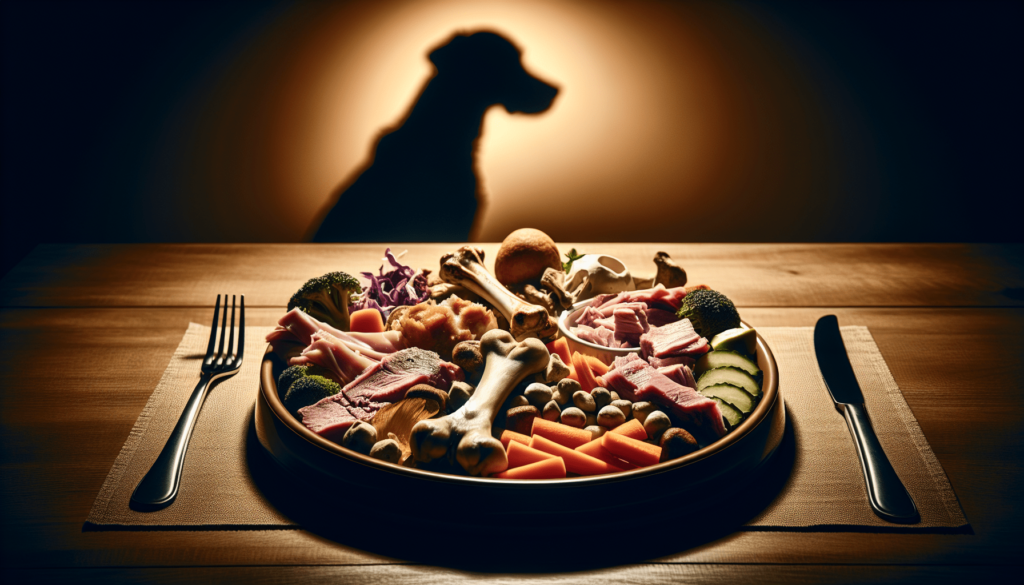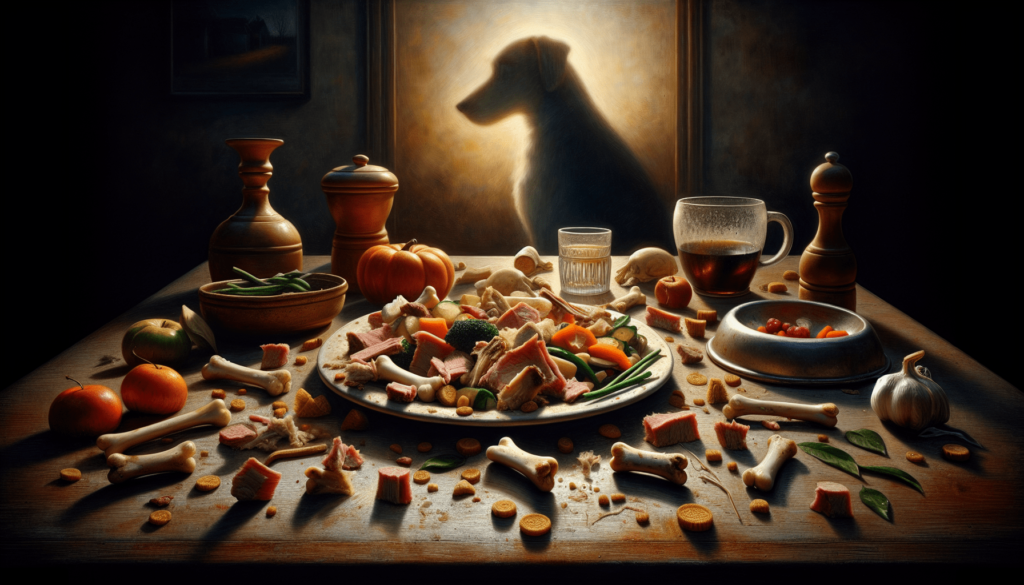Have you ever found yourself tempted to slip your furry friend a bite of food from your plate? It’s undoubtedly hard to resist those pleading eyes and wagging tail as your dog stares longingly at your meal. However, feeding dogs table scraps might not be the act of love we imagine it to be. Instead, it could pose several risks to their health and well-being.

What Are Table Scraps?
Before diving into the risks, let’s clarify what we mean by “table scraps.” These are the leftover bits of food from our meals that aren’t consumed and might include everything from the edges of toast to pieces of steak or vegetables doused in sauces. While these foods may seem harmless to us, they can be quite problematic for dogs.
Why We’re Tempted to Share
The desire to share our food with dogs often stems from the bond we have with them. Many of us view our dogs as family members, and sharing food is a universal gesture of care and companionship. However, what’s nutritious and safe for humans isn’t always the same for dogs, leading to potential health issues.
The Risks of Feeding Dogs Table Scraps
Feeding dogs table scraps can lead to an array of issues, ranging from immediate digestive upset to long-term health complications. Below, I’ll explain the primary risks associated with this practice.
1. Digestive Upset
Dogs have a different digestive system than humans, and sudden changes can upset their stomachs. Table scraps, especially those seasoned with spices or oils unfamiliar to them, can lead to vomiting, diarrhea, or both.
2. Obesity
Many table scraps are high in calories, fats, and sugars, contributing to weight gain and obesity in dogs. Obesity is a significant health concern and can lead to joint problems, diabetes, and decreased lifespan in dogs.
3. Pancreatitis
Certain fatty foods, particularly those high in oils and fats like bacon, can trigger pancreatitis in dogs. This serious condition arises when the pancreas becomes inflamed, causing pain, vomiting, and lethargy.
4. Toxic Ingredients
Several common ingredients in human food can be toxic to dogs. For instance, chocolate is notorious for causing toxicity, leading to symptoms such as seizures and, in severe cases, death. Similarly, grapes, raisins, onions, garlic, and certain artificial sweeteners are harmful.
| Ingredient | Effect |
|---|---|
| Chocolate | Seizures, potential death |
| Grapes/Raisins | Kidney failure |
| Onions/Garlic | Anemia |
| Artificial sweeteners (e.g., xylitol) | Liver failure |
5. Behavioral Issues
Once dogs get a taste of human food, they can become relentless beggars. This behavior is not only annoying but can also lead to dogs becoming overly focused on their human’s meals, reducing their interest in dog food and affecting their nutrient intake.

Healthier Alternatives to Table Scraps
If you’re eager to treat your dog, there are healthier options. Choosing the right treats ensures your pup remains happy and healthy. Always consult with a veterinarian when introducing significant changes to your dog’s diet.
1. Commercial Dog Treats
Many excellent dog treats are specifically formulated to be both safe and enjoyable for dogs. These are nutritionally balanced and come in flavors that dogs adore.
2. Fruits and Vegetables
Certain fruits and vegetables can be great treats for dogs if they’re prepared properly. Small pieces of carrot, apple (without the seeds), or plain pumpkin can be given occasionally as a healthy snack.
3. Home-Cooked Dog Treats
Making treats at home allows you to control what goes into your dog’s snacks. Research dog-safe recipes that omit harmful ingredients and provide nutritional benefits.
Creating a Healthy Feeding Routine
Maintaining consistency in your dog’s diet is crucial to their health. Developing a routine helps manage their weight and ensures they receive their necessary nutrients.
1. Scheduled Mealtimes
Offering meals at the same times each day helps regulate your dog’s digestion and energy levels. It also reduces the chances of begging if they know meals are prompt and routine.
2. Portion Control
Using a measuring cup for dry food or following vet-recommended portion sizes prevents overfeeding. Remember that treats should account for only a small percentage of your dog’s daily caloric intake.
3. Preventing Begging
Training your dog not to beg involves establishing boundaries. Implement commands like “go to your place” during mealtimes and reinforce positive behavior with praise rather than food.
Understanding Dog Nutrition
Knowing what nutrients your dog needs will influence what they should eat. Dogs require a balance of proteins, fats, carbohydrates, vitamins, and minerals to thrive.
1. Protein
Protein is essential for muscle development and energy. Ensure your dog’s food has a high-quality protein source.
2. Fats
Healthy fats support skin, coat, and brain health. Look for sources like fish oil which offers omega-3 fatty acids.
3. Carbohydrates
Carbs provide energy and should be present in moderation. Most commercial dog foods will have the right balance.
4. Vitamins and Minerals
Dogs need a complete range of vitamins and minerals which are typically found in commercial dog foods designed for their specific life stage and size.
The Vet’s Perspective
Veterinarians recommend against feeding dogs table scraps for good reasons. Discussing your feeding habits with a vet guarantees that your dog’s nutritional needs are met and that they’re on a diet suitable for their specific health.
1. Tailoring Diets
Dogs have distinct dietary needs based on age, breed, size, and health conditions. Vets can advise on special diets for weight management, allergies, or other health considerations.
2. Recognizing Symptoms
Understanding how to identify signs of dietary distress or toxicity, like excessive thirst, lethargy, or unusual behavior, is essential. Immediate veterinary attention can prevent complications.
FAQs About Feeding Dogs Table Scraps
Q: Is it ever okay to feed my dog table scraps?
A: Occasionally, some dog-safe foods may be fine in tiny amounts. It’s crucial, however, to know which foods are safe and always practice moderation.
Q: Can feeding table scraps lead to picky eating habits?
A: Yes, dogs might develop a preference for rich human foods over their balanced dog food, leading to nutritional deficiencies.
Q: What should I do if my dog eats something toxic?
A: Contact a veterinarian or an emergency pet poison helpline immediately for guidance on specific actions to take.
Understanding the risks associated with feeding dogs table scraps can go a long way in ensuring their health and well-being. While sharing food is an expression of love, ensuring your dog’s safety should always come first. Remember, there are plenty of ways to show affection that don’t involve feeding potentially harmful foods.



